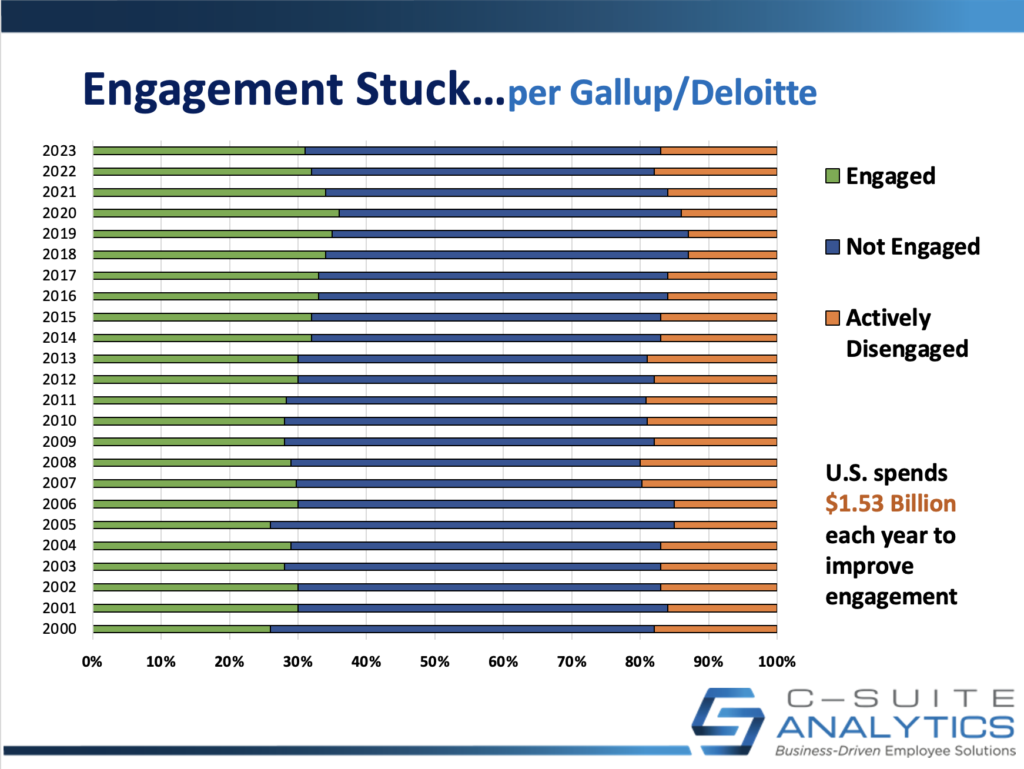Most hiring tools answer whether candidates can and will do the job, but not if they’ll stay. Learn how realistic job previews and motivational-fit interviews can improve retention from day one.
Why Hasn’t Engagement Improved in 24 Years?

Gallup has been reporting on employee engagement for the past 24 years, beginning in 2000. Each year they declare the percentages of employees who are engaged, disengaged, and actively disengaged, defined as follows:
- Engaged Employees – Engaged employees work passionately and feel a profound connection to their company. They drive innovation and move the organization forward.
- Disengaged Employees – Not engaged employees are essentially ‘checked out.’ They’re sleepwalking through their workday, putting time — but not energy or passion — into their work.
- Actively Disengaged Employees – Actively disengaged employees aren’t just unhappy at work; they’re busy acting out their unhappiness. Every day, these workers undermine what their engaged coworkers accomplish.
—–
Further reading: Who Jeopardizes Engagement the Most? Gallup Math Says It’s Managers
—–
Gallup’s reporting includes both U.S. and Canadian employees, and here are their results since 2000:

The chart tells us that over a full 24-year period there have been small gains and small losses, but that overall there has been little positive movement at all. And Gallup recently announced that early in 2024 employee engagement had reached an 11-year low.[i]
Gallup attributes this absence of engagement improvement to areas like lack of job clarity, a short supply of manager skills, and survey burnout among other reasons. But here is the real reason:
Firstline managers are hardly if ever held accountable for increasing their employee engagement scores.
I reported this first in 2018 in my book titled How to Raise Your Team’s Employee Engagement Score.
A Gartner report tells us that a full 74% of U.S. companies conduct annual employee surveys[ii]. And what do they do with the data? Here’s a very common process using lack of employee recognition as an example:
- HR pulls together an employee committee to solve employee recognition.
- After three meetings the committee presents its report.
- The top recommendations are to schedule employee of the month, employee of the year, and employee appreciation week…and also provide a backpack for five years of service and a clock for ten.
- One year later, the employee recognition score is the same or worse.
When employees complain about lack of recognition, the last thing they want to do is watch someone else win an award. And the first thing they want is for their manager to tell them they did a good job.
Manager accountability for engagement is nowhere. I recently asked a crowd of 500 SHRM attendees to raise their hand if they’ve ever known of a manager to be fired for a continual low engagement score. No hands went up.
This process of conduct a survey/wait a month for results/ develop one-size-fits-all programs/re-survey a year later with no improvement is as outdated as suitcases without wheels, the ones we used to carry through airports.
Consider this Gallup quote:
Gallup’s most profound finding — ever — is probably this: 70% of the variance in team engagement is determined solely by the manager.[iii]
So the obvious question becomes that if engagement is mostly driven by direct supervisors, why then do we think we can improve engagement with one-size-fits-all programs that do nothing to improve manager/employee relationships? These programs like town hall meetings, career ladders, and better benefits look as though they are designed to work around manager relationships rather than improve them.
—–
Further reading: Best Employee Engagement Gauge: 1-Day Survey or 1-on-1 Conversation?
—–
Why Don’t Companies Focus on First-Line Supervisors to Improve Engagement?
Because they don’t know how. Their best move is to ask managers to submit engagement improvement plans and then never follow up to see if the manager executed their plans. Nor do they have a critical eye to provide feedback to the manager on whether the plan would work, whether it would actually improve engagement. And worse, no one compares managers’ scores from year to year in order to coach or fire those managers who just don’t have the required skills, energy, or interest.
If employee engagement really mattered to executive teams, they would fire a few managers each year who failed to increase their scores over time. These are the same executives who throw around terms like culture, best place to work, and employer of choice, yet they saddle some of their best workers with an ill-equipped supervisor.
The Fix That Works for Engagement
Here’s an easy way to improve engagement that neither Gallup nor any other consultant will tell you:
- Structure your survey reporting so you get reports with scores as far down the organization chart as possible.
- After the first administration, provide each of your first-line supervisors with a specific and measurable goal for the next survey administration, and for most companies this is the following year.
- Train your leaders to conduct Stay Interviews the right way, the way I invented Stay Interviews to be put into place, and ask them to build one-on-one engagement plans with each member of their teams.
- Then hold them accountable to achieving their goal score.
- If they miss, ask for details about their Stay Interviews and then coach them…or can them.
This is the cousin to how our client companies improve employee retention consistently by 20% and more.
In-Person Employee Retention Intensive for Leaders
Are you committed to improving employee retention and engagement? Then join us this September in Orlando for two-and-a-half days of intensive training specifically designed for HR leaders who need to cut turnover, improve employee engagement, and decrease recruiting spend in the most cost-effective way. Based on Dick Finnegan’s ground-breaking, our expert facilitators will equip you with all the tools you need to implement your retention strategies to build a thriving, engaged workplace culture. Secure your spot today!
[i] https://www.gallup.com/workplace/647564/employee-engagement-inches-slightly-year-low.aspx
[ii] https://www.gartner.com/smarterwithgartner/is-it-time-to-toss-out-your-old-employee-engagement-survey
[iii] https://www.gallup.com/workplace/395210/engage-frontline-managers.aspx#:~:text=business%20success%20soars.-,Gallup’s%20most%20profound%20finding%20%2D%2D%20ever%20%2D%2D%20is%20probably%20this,determined%20solely%20by%20the%20manager.&text=Managers%20are%20the%20difference%20between,retain%20and%20engage%20their%20teams.



